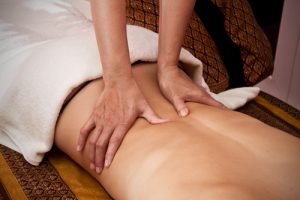Sciatica pain during middle age is common. The good news is that the treatments discussed here offer relief for sciatica sufferers.
Sciatica pain travels down the sciatic nerve path, which starts at your lower back region and branches out through your hips and legs. The pain can range from mild irritation to severe discomfort.
Causes and Symptoms of Sciatica Pain During Middle Age
Mayo Clinic reports the causes of this pain are a spinal bone spur, nerve compression from the narrowing of the spine or a herniated disk. While a small percentage of younger people suffer from this condition, sciatica pain is much more prevalent during middle age.
Sciatica pain is essentially nerve pain from irritation or an injury. Cleveland Clinic cites a herniated disk that puts pressure on the nerve root as the most likely cause of the majority of sciatica pain problems.
Symptoms of sciatica include the following:
- Pain in lower back, buttocks, legs, feet or toes
- Muscle weakness in leg or foot
- Tingling sensation in leg, foot and toes
- Numbness in legs
Sciatica Treatments
Some proven remedies for improving sciatica symptoms are the following:
Massage therapy offers 
While many people avoid taking medication for pain, sometimes it is the fastest way to eliminate severe symptoms. WebMD recommends starting with popular over-the-counter (OTC) pain relievers such as acetaminophen, ibuprofen and aspirin first. It is important to remember that these medications should be taken only for a short period of time using recommended guidelines.
Prescribed medications like muscle relaxers, tricyclic antidepressants and anti-seizure medications have also proven to be effective for some people when OTC drugs don’t work. Steroid injections are another viable option offered for some temporary relief in the worst cases.
Chiropractors can also offer pain relief via manual manipulation that helps align the spine. The hope is that this type of treatment will eliminate the root of the problem. Herniated disks and the narrowing of the spine or spinal stenosis often respond positively to this hands-on treatment. It is important to remember that manual manipulation techniques offered by chiropractors should not be painful.

Reclining Pigeon Pose
While on your back on the floor, lift your right leg up forming a right angle, then lock your hands behind your thigh to support it. Repeat on the other leg. This stretches the piriformis muscle.
Spinal Stretch
Sit on the floor with your legs in front of you and your toes pointed up. Then, bend your left knee and position your foot on the floor away from your body frame beside your other knee. Next, turn your body by setting your right elbow outside your left knee and hold that position for 30 seconds. Repeat this maneuver three times, then switch knees.
Sitting Pigeon Pose
Position yourself sitting on the floor with your legs stretched out in front. Then, bend your right leg up, placing your ankle on your left knee, leaning forward for 15 to 30 seconds to stretch your lower back and glutes. Repeat this with the other leg.
Summary
You can treat sciatica pain during middle age by using the tips mentioned above. While surgery is typically not required, it is another option for people who have exhausted all other options. Stretching exercises represent a good first option for pain relief.





